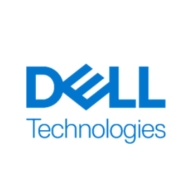

Cisco Nexus and Dell PowerEdge R-Series compete in the domain of data center technologies. Each product has distinct advantages, with Cisco Nexus leading in reliability for high-performance environments, while Dell PowerEdge R-Series is more cost-effective and flexible for diverse business needs.
Features: Cisco Nexus is praised for its speed, flexibility, and routing capabilities, essential in data centers. It supports intensive workloads via features like VXLAN and PPC and offers modularity and high-density ten-gig capabilities, enhancing its value in virtual environments. Dell PowerEdge R-Series is valued for superior performance and scalability, handling demanding tasks efficiently. Its robust remote management through iDRAC and simplified updates streamline operations.
Room for Improvement: Cisco Nexus faces challenges with complex licensing and limited integration with newer tech. Users call for better central management and easier configuration. Dell PowerEdge R-Series could improve its environmental footprint by optimizing power consumption and noise levels. Competitive pricing and quicker support access are also desired, alongside more configuration options and better AI workload integration.
Ease of Deployment and Customer Service: Cisco Nexus offers a seamless deployment experience with comprehensive technical support though some users face service quality inconsistencies. Dell PowerEdge R-Series is known for straightforward deployment with excellent global support. While its customer service is highly regarded, enhancing local support and speeding up deployment times could boost satisfaction.
Pricing and ROI: Cisco Nexus, considered expensive, presents complex licensing challenges but offers high ROI via stability and reduced downtime. Its reliability justifies the upfront investment. Dell PowerEdge R-Series provides competitive pricing, balancing initial cost with maintenance savings. Its user-friendly pricing and substantial ROI make it appealing for cost-sensitive environments.
Speeding up our response times and reducing errors and incidents with automation and available APIs.
By not having to worry about it, I would estimate we save two to four hours a week, depending on what's happening, such as if we need to spin up a new server, which would contribute to more time if done the old way.
In my immediate case for antenna analysis, Dell PowerEdge Rack Servers offer a reduction from days of computing to half a day or hours.
The value of uptime to us is critical.
For us, we have a time advantage because we know the solution, and the technological refresh is easier.
It has always been scheduled maintenance, which says a lot for a production environment, as we haven't had to call in a trouble ticket for the actual hardware during its entire run.
Typically, the contacts we have on-site are very knowledgeable, they come in within a day and usually have it fixed and taken care of if there are issues.
When we had a power supply failure out of the box, we called support, and they delivered the replacement within four hours as promised.
The scalability of Dell PowerEdge Rack Servers is excellent.
Any outages or blackouts are limited to particular servers, not affecting the whole chassis or enclosures.
We bought our product with scaling involved, and we've been scaling it up anytime we've needed more storage.
Initially, the stability of Cisco Nexus, particularly with the ACI, was problematic due to unstable codes, requiring replacements.
Over four years, we've had less than 1 percent downtime.
There is a feature to update the server while it is running, so there is no need to restart.
We have truly not had any downtime on the infrastructure at all.
When I talk about data centers, which are critical infrastructure and centralized application hubs, the Nexus platforms should be highly stable.
The solution is on-premises and stable.
It might be pretty expensive for other companies.
We need to know about any upcoming updates so that we can plan accordingly.
The beneficial aspect of that feature was that we could skip the PowerStore and just have the Dell PowerEdge Rack Servers alone, as they also served as storage, which helped us save money.
This forces you to go up to a larger server to get the desired processor, which increases the cost.
The price of Cisco Nexus is on the higher side due to the premium services Cisco offers.
All solutions are very expensive and not an economy solution.
They have been stable and running for years without performance downtime or significant disc failures.
Some customers find it cheaper due to contractual agreements, while others find it expensive, especially when scaling up.
The software associated with servers, like VMware subscription licenses, drives costs.
The VPC feature of Cisco Nexus is great because it provides an active-active way of forwarding the traffic and avoids blocking any of the links.
For us, we have a time advantage because we know the solution, and the technological refresh is easier.
I would recommend Cisco Nexus for large enterprises and the government sector, as they can afford it.
They keep running for at least five to seven years without any issues.
With PowerEdge Servers, I don't need a one-to-one ratio redundancy, which leads to about eighty percent downtime reduction.
One of the valuable features is Active Directory, which helps in managing the network.
| Product | Market Share (%) |
|---|---|
| Dell PowerEdge R-Series | 1.7% |
| Cisco Nexus | 17.8% |
| Other | 80.5% |


| Company Size | Count |
|---|---|
| Small Business | 19 |
| Midsize Enterprise | 17 |
| Large Enterprise | 82 |
| Company Size | Count |
|---|---|
| Small Business | 79 |
| Midsize Enterprise | 52 |
| Large Enterprise | 95 |
PowerEdge R-Series delivers high performance, flexibility, and scalability for data centers. It supports demanding tasks with robust management tools and advanced cooling, providing reliability and efficiency across various workloads.
Engineered for large deployments, PowerEdge R-Series supports extensive configurations optimizing performance in data centers. With features like advanced cooling and energy-efficient architecture, it empowers organizations to manage heavy workloads while facilitating seamless scalability. It offers remote management, robust security, and integration with VMware ensuring operational excellence and high availability for business-critical applications.
What are the key features of Dell PowerEdge R-Series?PowerEdge R-Series is deployed across industries for virtualization, database hosting, and application servers. It supports environments like VMware and Hyper-V for AI, cloud infrastructure, and computing tasks. Widely used by finance, healthcare, and academia, it enhances reliability and efficiency of IT infrastructure.
We monitor all Data Center Networking reviews to prevent fraudulent reviews and keep review quality high. We do not post reviews by company employees or direct competitors. We validate each review for authenticity via cross-reference with LinkedIn, and personal follow-up with the reviewer when necessary.